MACARTHUR: “I HAVE RETURNED!”
Leyte, Philippines · October 20, 1944
In October 1944 Lt. Gen. Tomoyuki Yamashita commanded 225,000 Japanese soldiers in the Philippines. On this date in 1944, on a 25‑mile stretch of Leyte Island in the Philippines, an Allied fleet of more than 730 transport and escort vessels, supported by aircraft carriers and 100 warships, put 160,000 U.S. troops ashore under the watchful eye of Gen. Douglas MacArthur aboard the USS Nashville. In the afternoon, MacArthur, wearing a crisply starched uniform and sunglasses, waded ashore from a landing craft—he repeated this again for the benefit of assembled press cameramen—approached a portable radio set, and spoke into the microphone: “People of the Philippines: I have returned!” Initially, the invading forces met minimal resistance, and Japanese reinforcements took significant casualties. In the last great naval battle of World War II, the Battle of Leyte Gulf (October 23–26, 1944), the Japanese Navy was decisively defeated in its attempts to intervene. Every facet of warfare was involved in the largest, most complex naval battle ever fought, one that engaged 200,000 men and close to 300 U.S., Australian, and Japanese ships over more than 100,000 sq. miles of sea. Ultimately, the Japanese had no answer to the Allies’ overwhelming land and air firepower and by December 25 Leyte was secured. Though it took the remainder of the war to subdue the enemy—e.g., the Battle of Manila (February 3 to March 3, 1945) cost the lives of 1,000 U.S. service members and 100,000 Filipino civilians—the fighting in the Philippines severed Japan’s lifeline to the mineral resources of the East Indies and sounded the death knell for the Empire of Japan. A continual flow of U.S. service personnel, augmented by new ships, carrier and land-based aircraft, tanks, artillery, rifles, ammunition, and other items pouring out of American factories, pushed the Japanese back more than 2,000 miles, back through the ruins of their inner defense ring, and back to the Home Islands themselves. Emperor Hirohito (posthumously referred to as Emperor Shōwa) sued for peace on August 15, 1945, after learning of the utter destruction of two Japanese cities (Hiroshima and Nagasaki) by a new weapon in the U.S. arsenal and hearing about the millions of Soviet soldiers who were making mincemeat of his Kwangtung Army on the Asian mainland.
[amazon_carousel widget_type=”ASINList” width=”600″ height=”200″ title=”Recommended Reading” market_place=”US” shuffle_products=”False” show_border=”False” asin=”1602391947,159114535X,0553381482,0230613977,1557502439,0891417567,1591146917,0891416161,0316024740,0253352428″ /]
The Philippines and the Chief Players in the Battle of Leyte Gulf
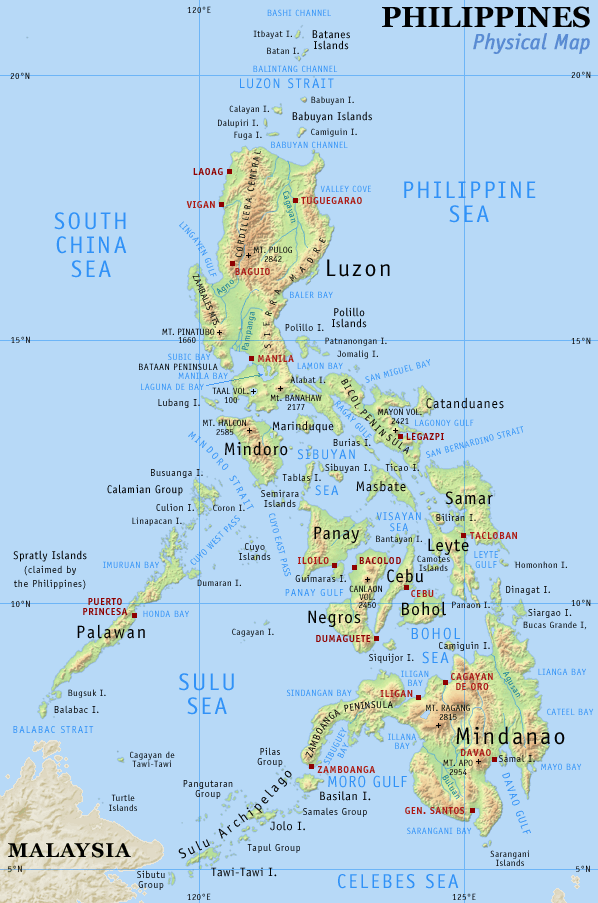 |
Above: Map of the Philippines showing the location of the islands of Luzon in the north and Leyte in the middle. Also in the middle is the San Bernardino Strait.
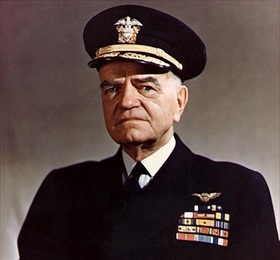 | 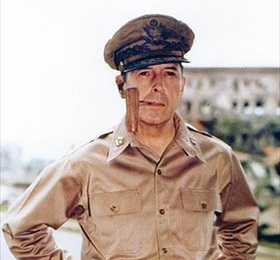 |
Left: Adm. William F. “Bull” Halsey (1882–1959) commanded the U.S. Third Fleet in June 1944 for the advance on the Japanese-held Philippines. While taking part in the Battle of Leyte Gulf, Halsey fell for Japanese Vice Adm. Jisaburo Ozawa’s ruse and led his 64‑ship fleet (Task Force 34) after 17 decoy ships, leaving both the San Bernardino Strait (between Luzon and Samar islands) and Gen. Douglas MacArthur’s invasion forces on the Leyte beaches unprotected. Nevertheless, Halsey sunk all four of Ozawa’s carriers, destroying the remnants of enemy naval airpower (Battle of Cape Engaño). In December 1945, Halsey was promoted to the rank of fleet admiral, becoming the fourth and last officer to hold that rank.
![]()
Right: Gen. Douglas MacArthur (1880–1964) commanded U.S. and Filipino servicemen on the eve of the World War II. After being caught by surprise by the Japanese assault on the Philippines, the evacuated general redeemed himself with a brilliant, hard-hitting campaign in the Pacific Theater that wore down enemy resistance. On V‑J Day, August 14, 1945, President Harry S. Truman appointed MacArthur Supreme Commander for the Allied Powers, or military ruler, in occupied Japan (1945–1950). He accepted Japan’s formal surrender for the United Nations on September 2, 1945, in Tokyo Bay.
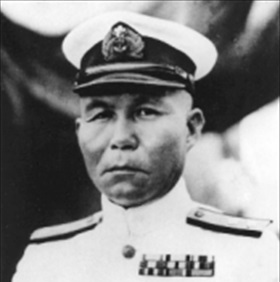 | 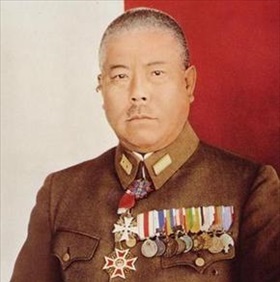 |
Left: Vice Adm. Jisaburo Ozawa (1886–1966) was responsible for Japanese naval operations in the South China Sea and was the last commander of the Combined Fleet, which Adm. William “Bull” Halsey had earlier decimated in the Battle of the Philippine Sea in June 1944. At the Battle of Leyte Gulf in October 1944, Ozawa came the closest of any Japanese commander to inflicting a reverse on the U.S. Pacific Fleet.
![]()
Right: Lt. Gen. Tomoyuki Yamashita (1885–1946) assumed the command of the Japanese Fourteenth Area Army in the Philippines in October 1944, ten days before U.S. forces landed on Leyte Island on October 20. Yamashita used delaying tactics until September 2, 1945, when his forces were reduced to under 50,000 by the tough campaigning by combined American and Filipino soldiers. Between October and December 1945, an American military tribunal in Manila tried Gen. Yamashita for war crimes relating to the Manila Massacre and many other atrocities in the Philippines and earlier in Singapore and sentenced him to death. He was hanged on February 23, 1946.
Battle of Leyte Gulf (October 1944) and the Liberation of the Philippines
![]()

 History buffs, there is good news! The Daily Chronicles of World War II is now available as an ebook for $4.99 on Amazon.com. Containing a year’s worth of dated entries from this website, the ebook brings the story of this tumultuous era to life in a compelling, authoritative, and succinct manner. Featuring inventive navigation aids, the ebook enables readers to instantly move forward or backward by month and date to different dated entries. Simple and elegant! Click
History buffs, there is good news! The Daily Chronicles of World War II is now available as an ebook for $4.99 on Amazon.com. Containing a year’s worth of dated entries from this website, the ebook brings the story of this tumultuous era to life in a compelling, authoritative, and succinct manner. Featuring inventive navigation aids, the ebook enables readers to instantly move forward or backward by month and date to different dated entries. Simple and elegant! Click 











